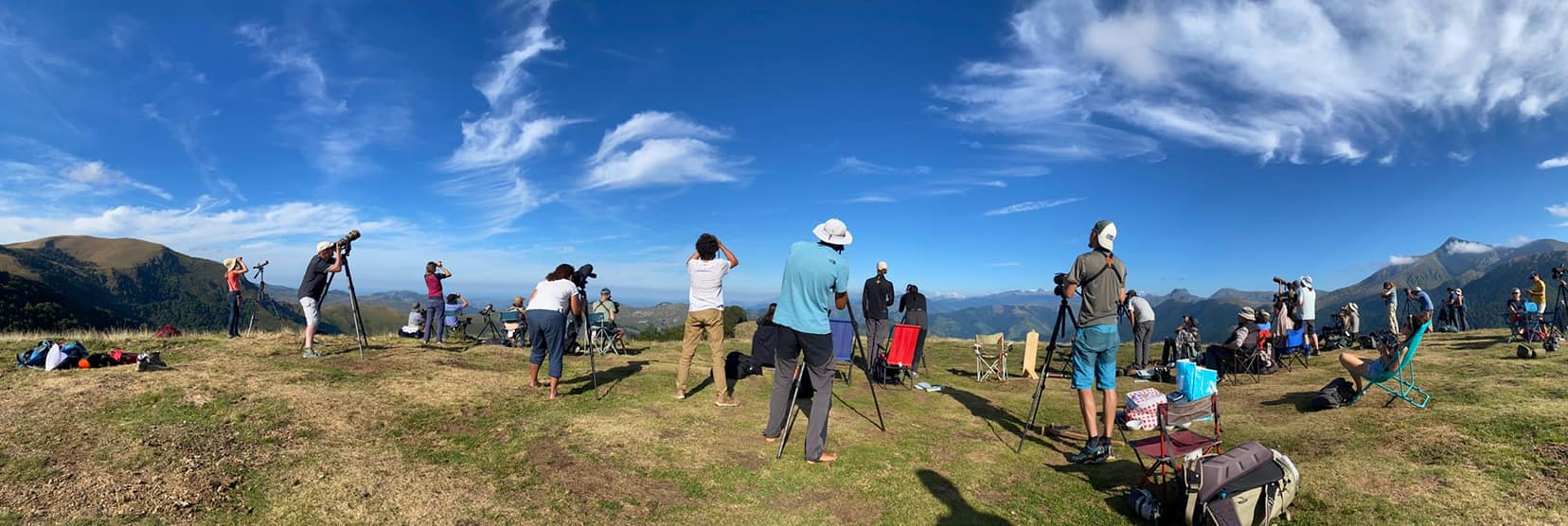Sacha’s notes from the field: Birds of a feather flock together
Sacha reflects on her experience monitoring migrating birds in Organbidexka and how individuals can play a huge part in making positive change in conservation
On a green grass hill, floating on a vast white cloud, thirty people sit in a line.
These international band of bird lovers, of many different ages, sit on flimsy seats, scopes and binoculars at the ready. We have come to Organbidexka, one of three mountain passes through the Pyrenees, where birds are counted throughout the migration season - mostly by volunteers.
Over the years, they have gathered critical data on the health of the raptors and other soaring birds using this flyway. And, alongside tracking the impacts of a changing climate, have acted as a deterrent to illegal hunting.
With only the hilltop protruding from a valley full of thick fog, few birds will be on the move. Relaxed multilingual banter fills the air, while an early morning orange sun bathes us in an orange glow. The serenity doesn’t last.

The sun and winds develop, blowing the cloud up and out of the valley. Then the first birds are spotted to the north, several km away, and the whole team switch to high alert. The first yell indicates number and position. Paul Capbern - of LPO (Ligue for Protection of Birds) - allocates it to an expert spotter and their assistant. They then follow the bird/flock on their entire passage up the valley and away to the south. In that time, they try to gather as much info on sex, age, ring numbers before they disappear from sight.
We are here at the end of the big migration of black kites, and the start of the migration of honey buzzards. Both species move through in large flocks tracking thermals through the valley. 4,646 black kites and 6,168 buzzards on the two days we were there. We learn to identify the booted eagle from other eagles at a distance by its ‘giss’ (GISS is a term that possibly came from an aviation term "General Impression of Size and Shape (of an aircraft)".
The Griffin vultures are the only birds no one is counting. As there are both resident and migratory Griffin vultures, it is impossible to know which birds are passing on migration, and which are on a daily flight. With the resident birds doing turns around the valley and reappearing, it would mean they would be counted multiple times each day, skewing data.
The vultures show where thermals form in the valley. They orbit in large flocks, wing spans the length of a man, riding thermals in widening circles up to cloud base.
But sometimes the vultures come in very close. If they get a stronger lift from the air being forced up the slope, which is in front of the team, they fly towards the grass hill and tuck in tight to the slope. They track in figures of 8, back and forth, each pass getting closer and closer to the observers, until they fly right in front of us all. When they are almost in our reach, they suddenly move over our heads, up and away, giving us an occasional curious glance.

Watching like a hawk
Only eight ospreys had been seen so far this year, so everyone is hoping to find one for us, although given the population size, the chances are slim.
“Balbuzard!!” A shout slices through the air.
Everyone turns, as the first of two ospreys we are to see, appears in the distance. Alone it tracks up the valley.But, 500 m before it reaches the hill, it bursts into flapping flight and tracks off down a valley that bends to the east, and south again. The second osprey we saw took the same route.
“The ospreys are strong, they are one of the few birds that will keep flying in a head wind, through cloud, even in some rain, and nearly always alone. You can see they have power,” Serge, an observer here for 42 years, tells us.
Of the many passes through the Pyrenees, there is something special about this site. Serge explains that in the 1980s there was an international effort mounted by a few individuals. Every year, for eight years, 300 volunteers stationed themselves right along the Pyrenees during migration. In that time, they identified sites with the biggest numbers of birds, but also the highest number shot down by illegal hunting.
They settled on three key sites for long term observations. Has it worked? On the ridge, Serge points out the small shelters used by hunters to hide behind. Since they started the program, hunting has seen a serious reduction. But, there would be hunters here still, if bird groups hadn’t bought almost all the hunting licences.
Another thermal comes through, bringing with it a warm breeze and a faint hum. Collectively, we look behind us, towards the dark green of the valley. Under the sun’s rays, we see small clouds, each one made-up of clusters of hundreds of insects.
An impressive sight. That is until the swifts - also on migration - arrive. A hundred or more bird ‘bullets’ appear, zoning in on the floating insect cloud buffet. The birds are oblivious to us humans as they dart between us, causing us to give audible gasps. Shivers, delight, awe, for a moment all focus is lost, as we absorb a moment of magic.
This stay at Organbidexka and the story of how it came to pass, remind me how important individuals have been in conservation efforts along the flyway, and the importance in big NGOs supporting those that demonstrate impact. We will be sharing more of these stories as the expedition moves into Africa.
If you want to visit or volunteer, contact LPO via Paul at paul.capbern@gmail.com

